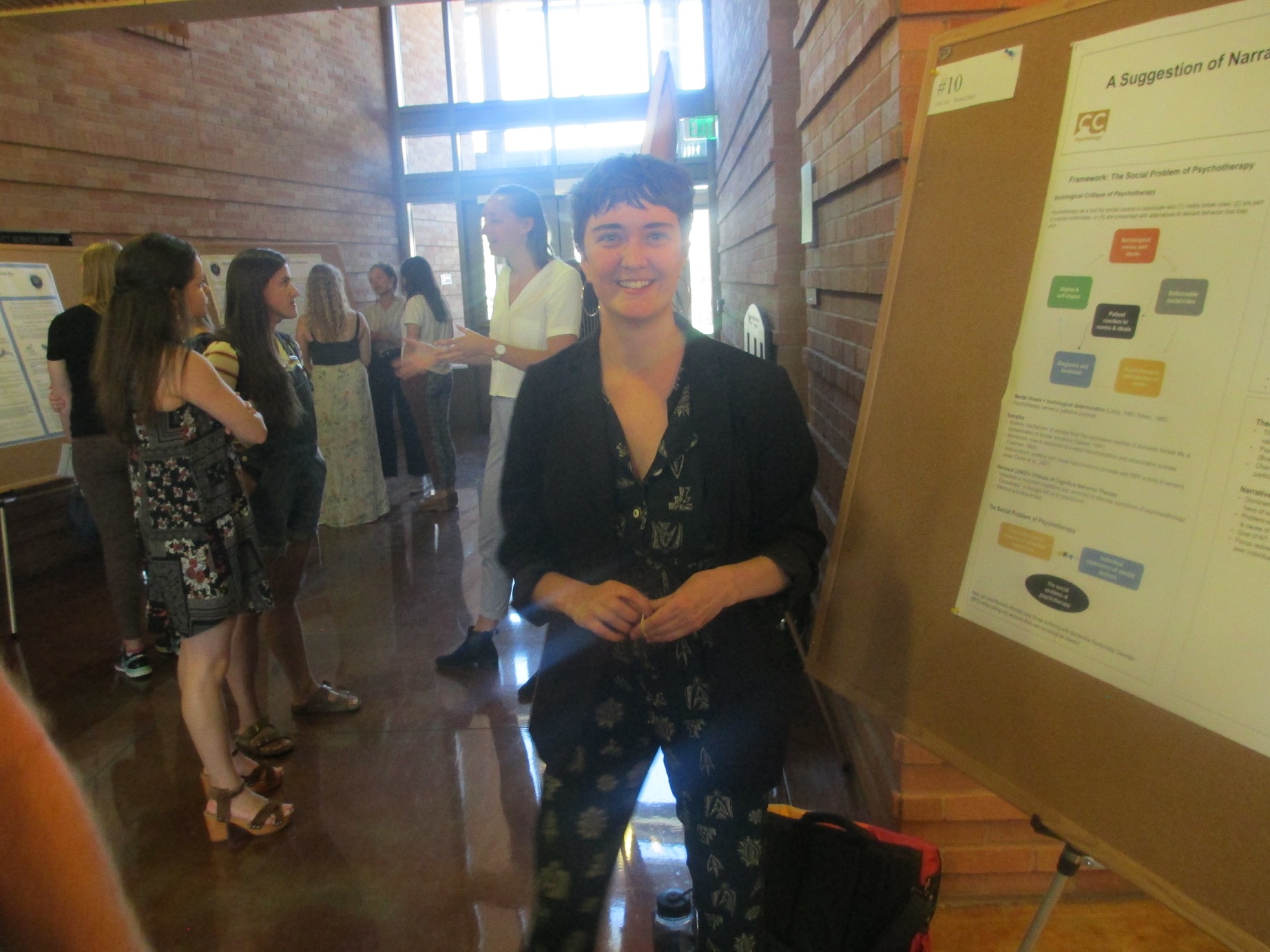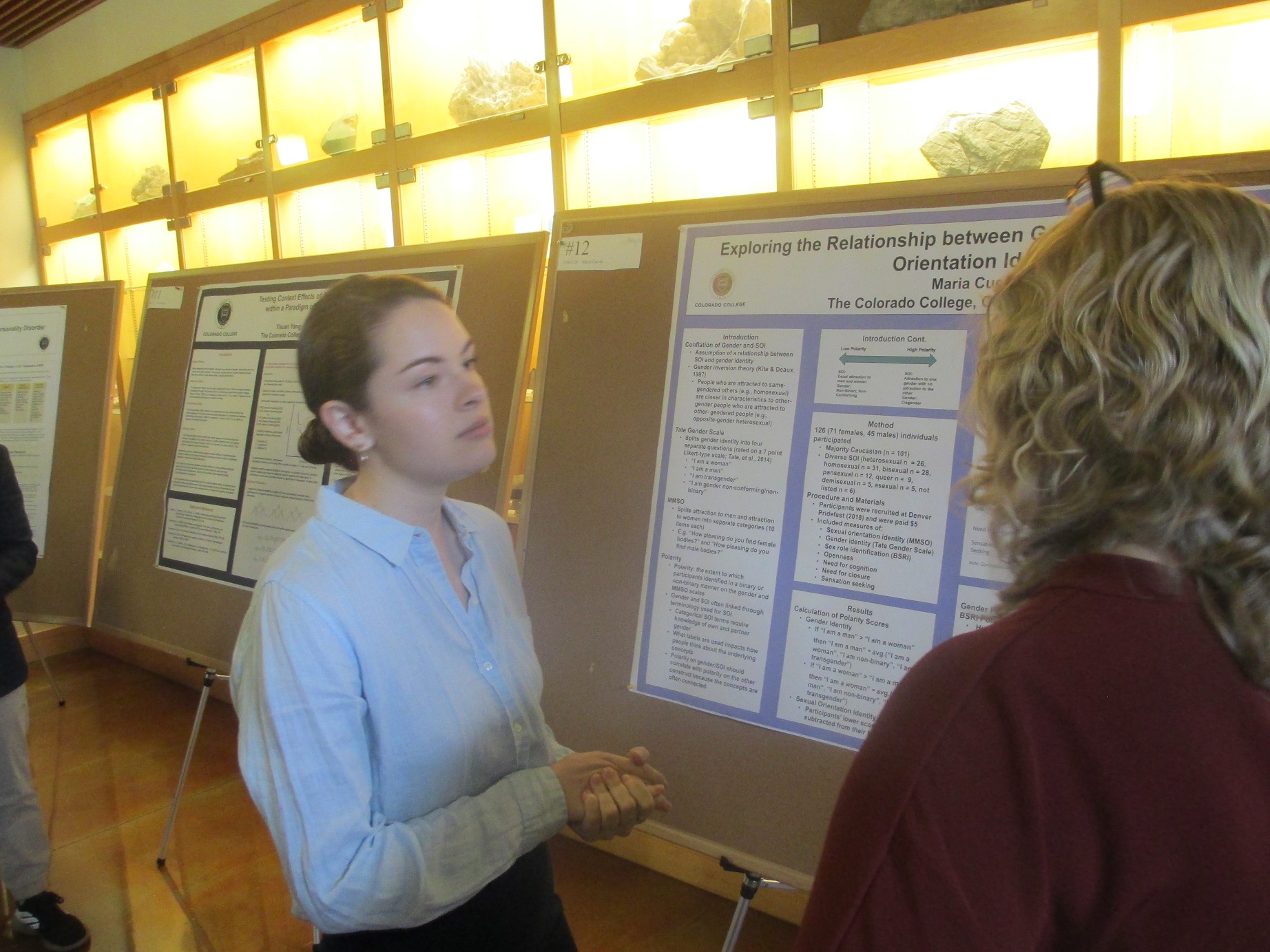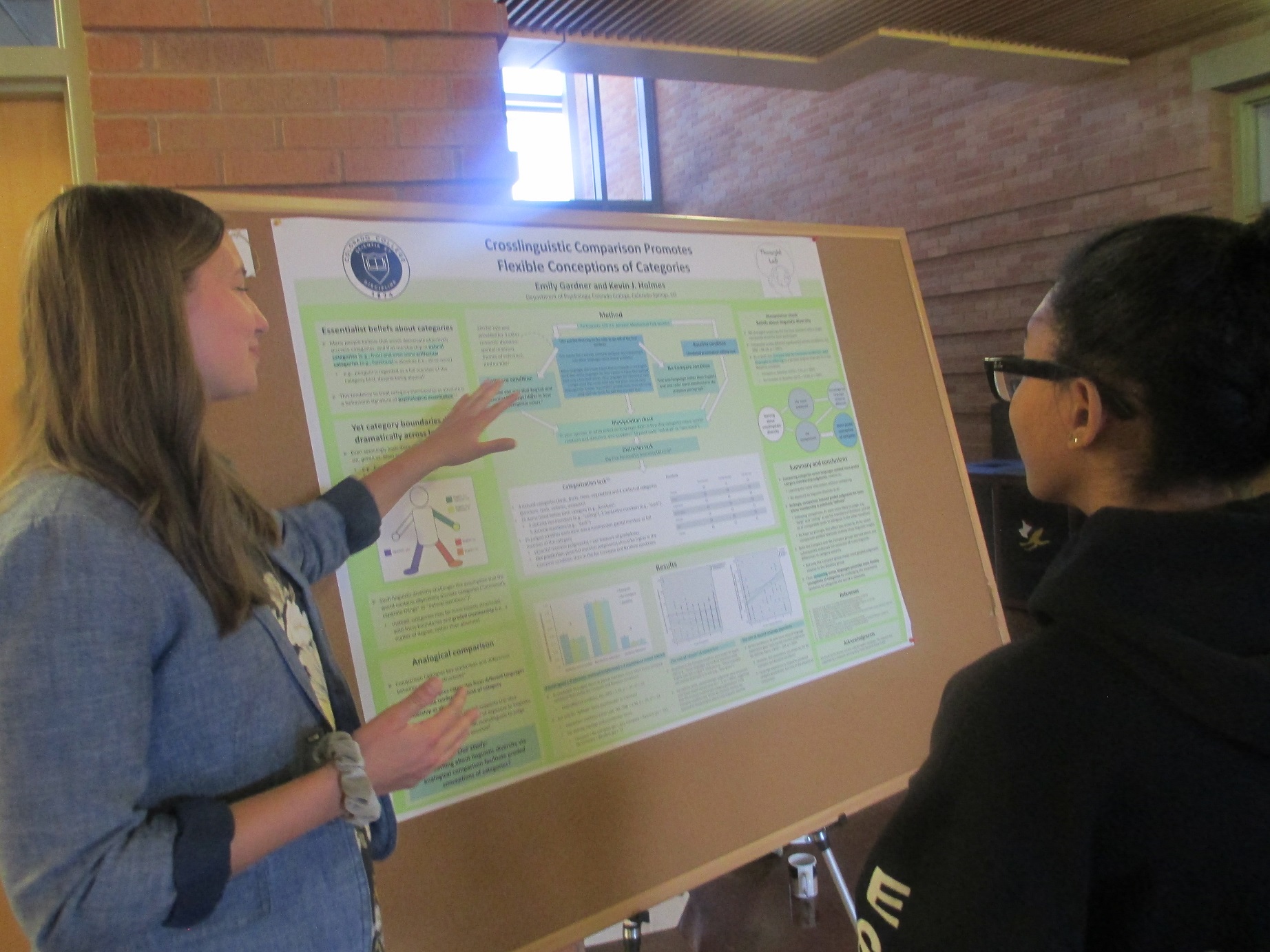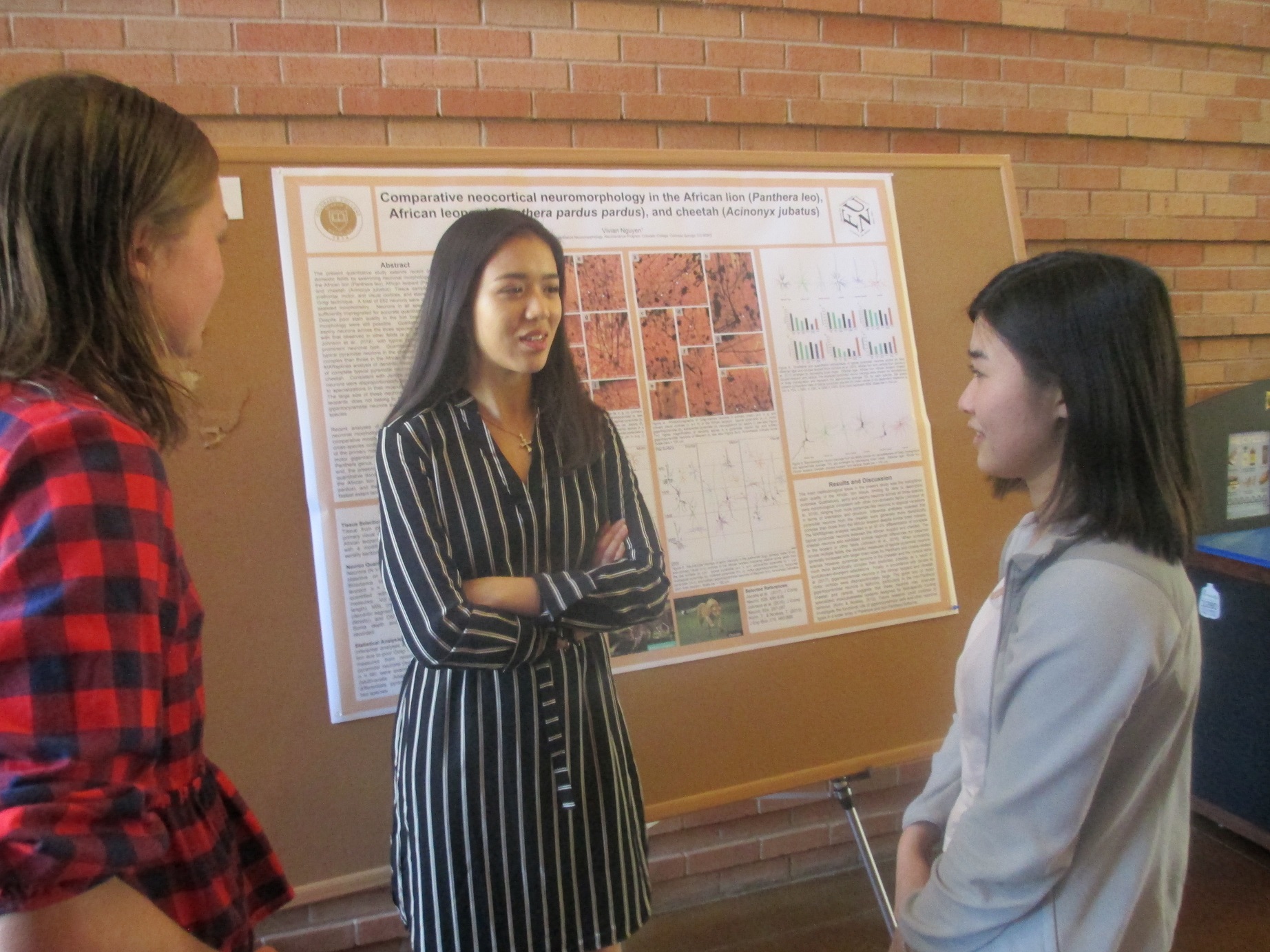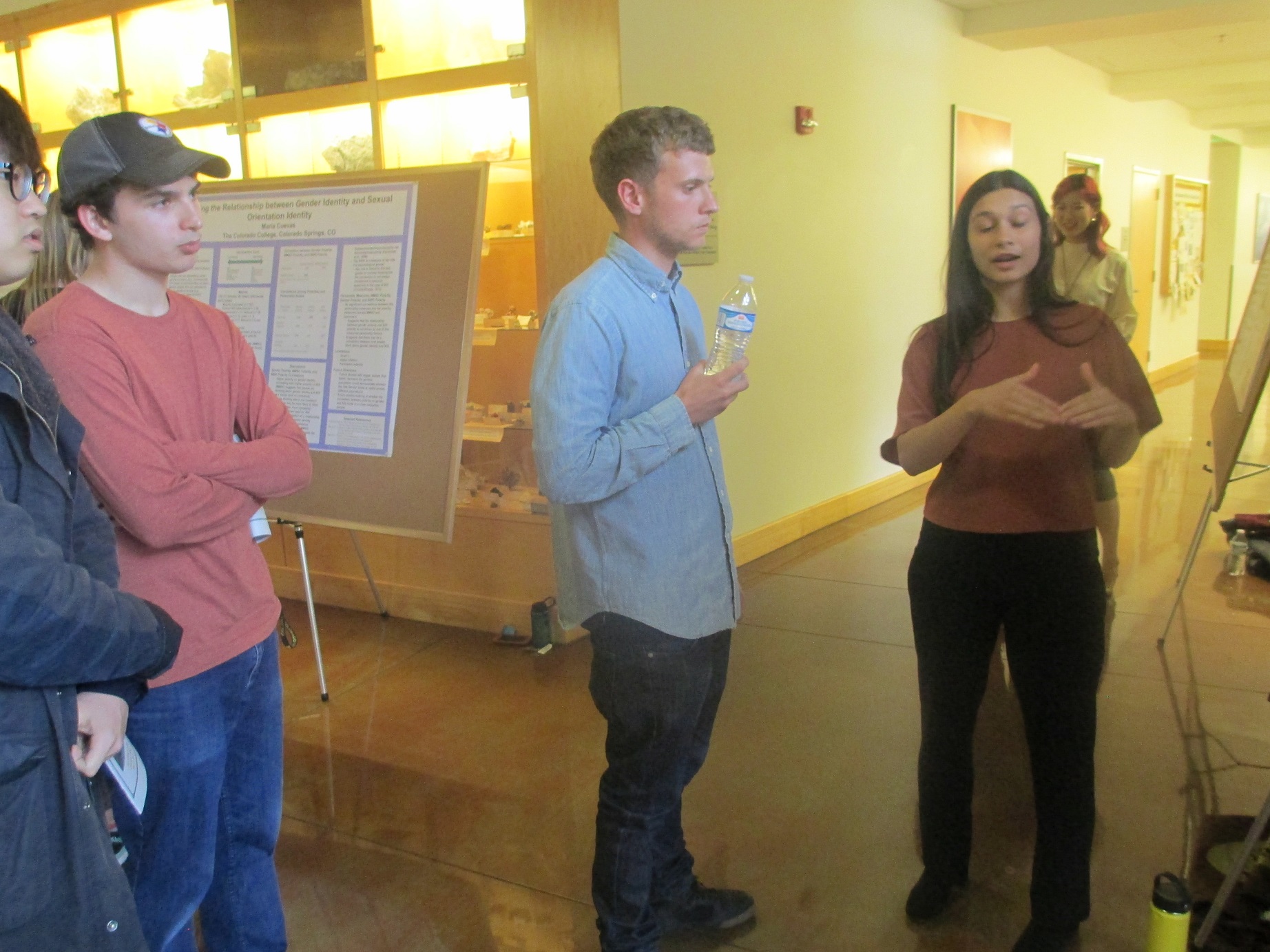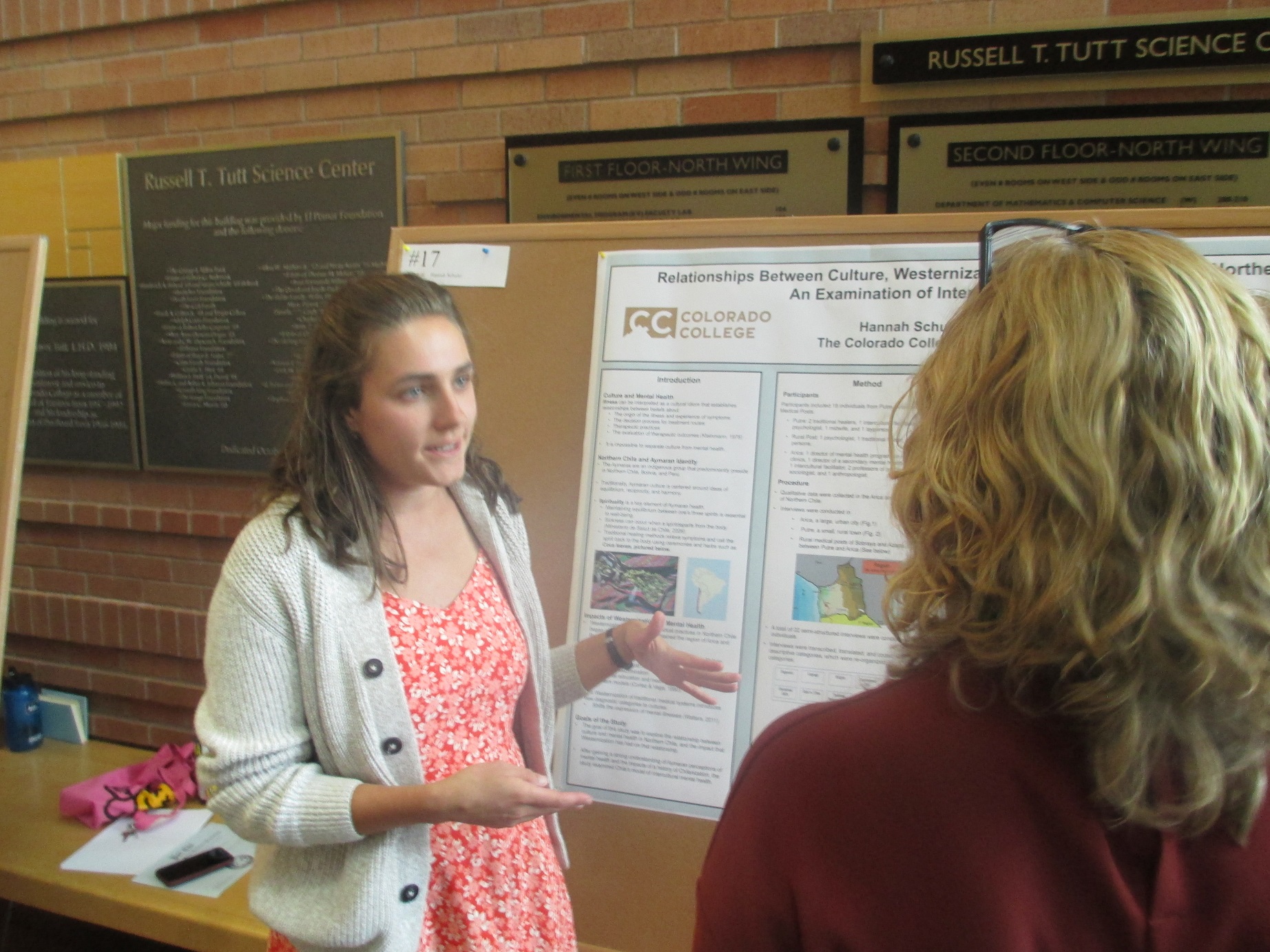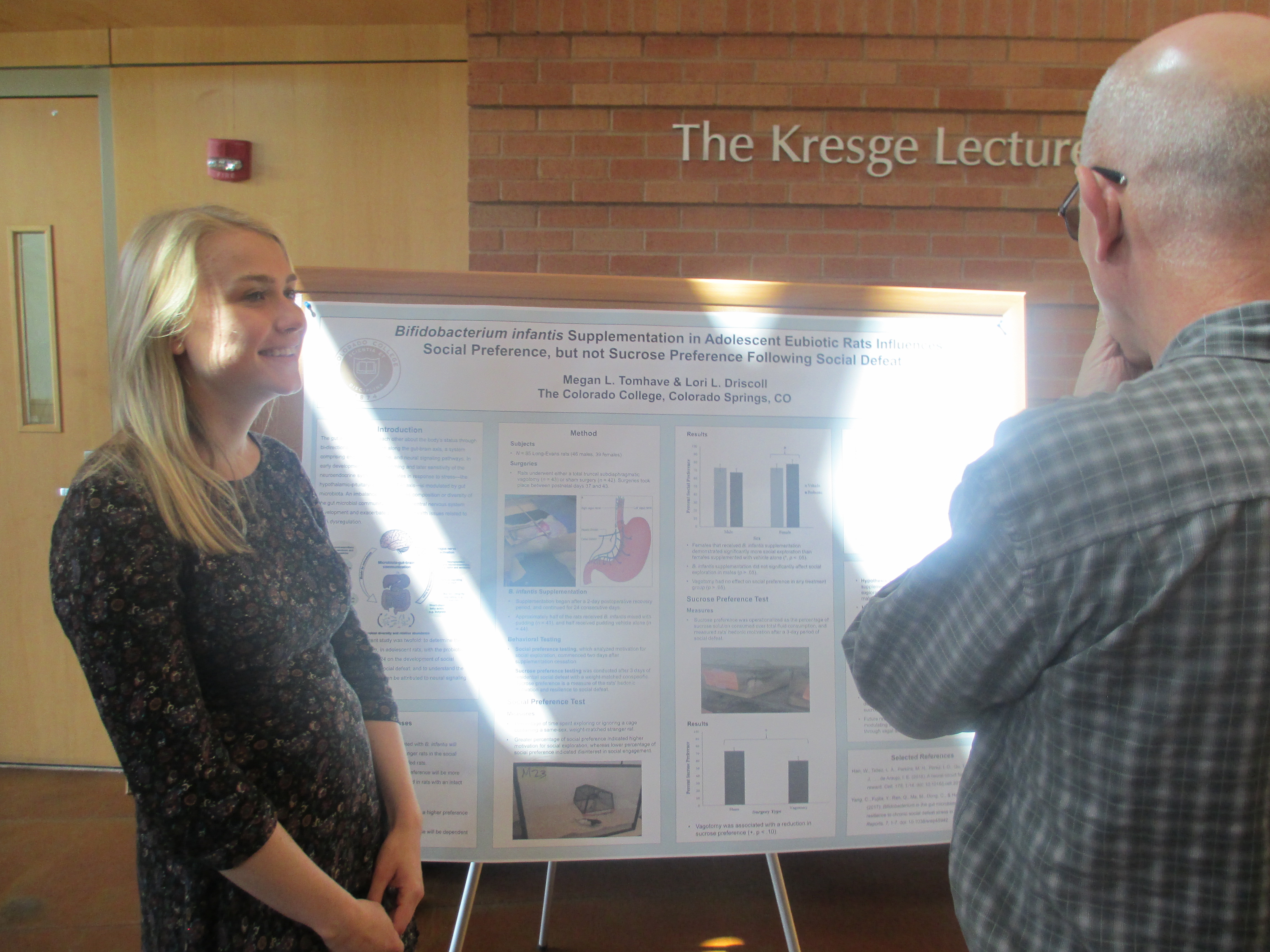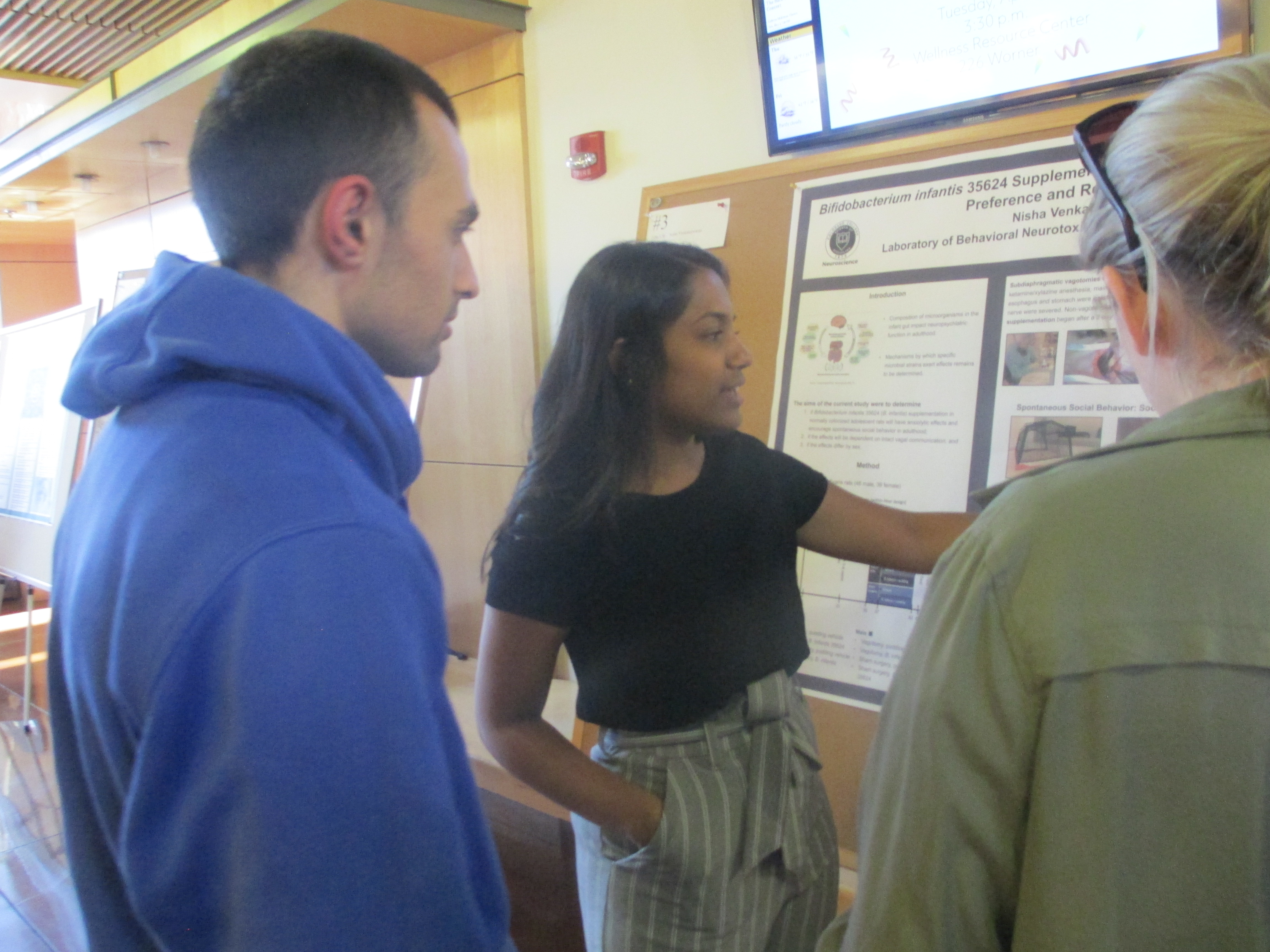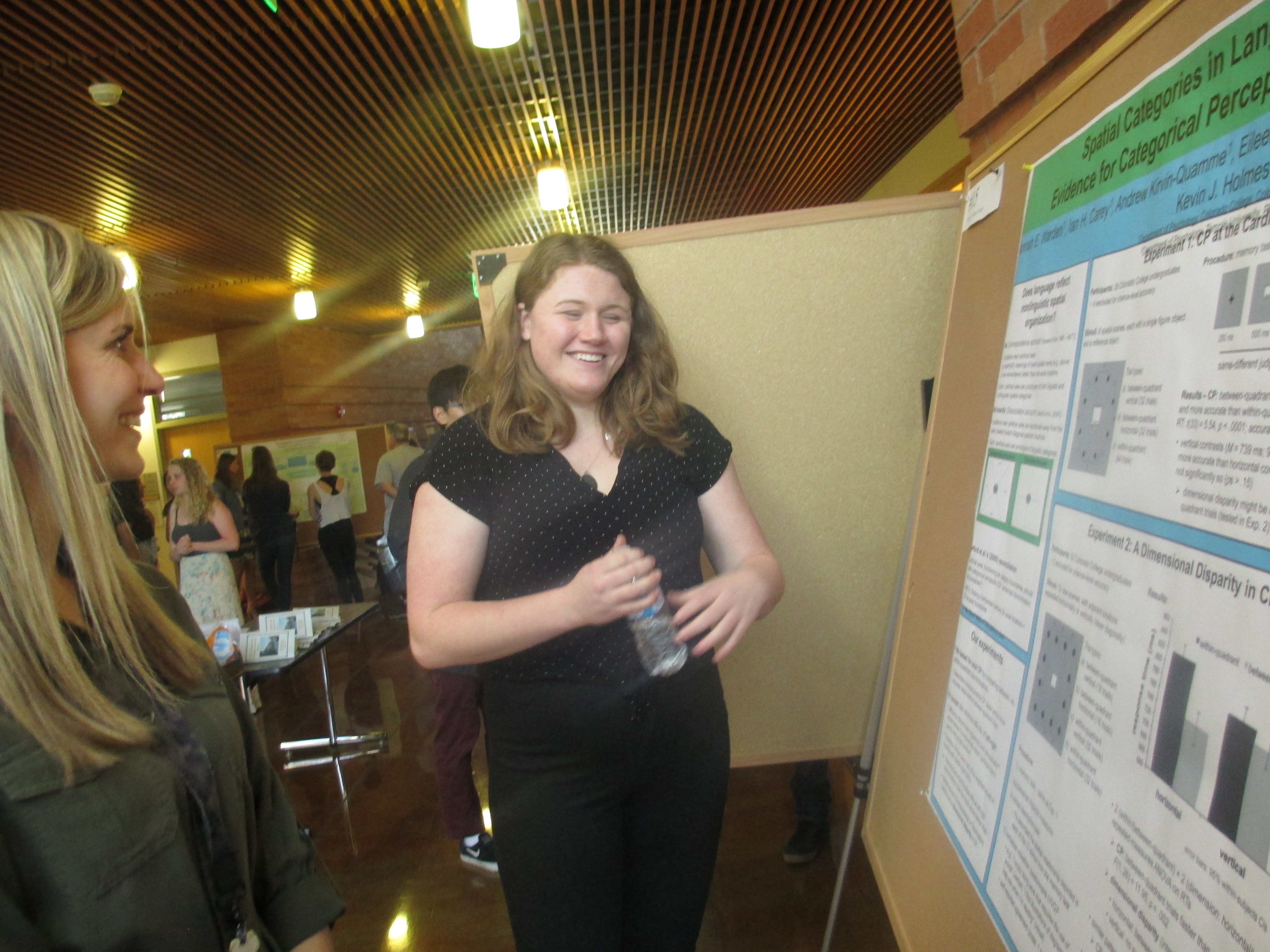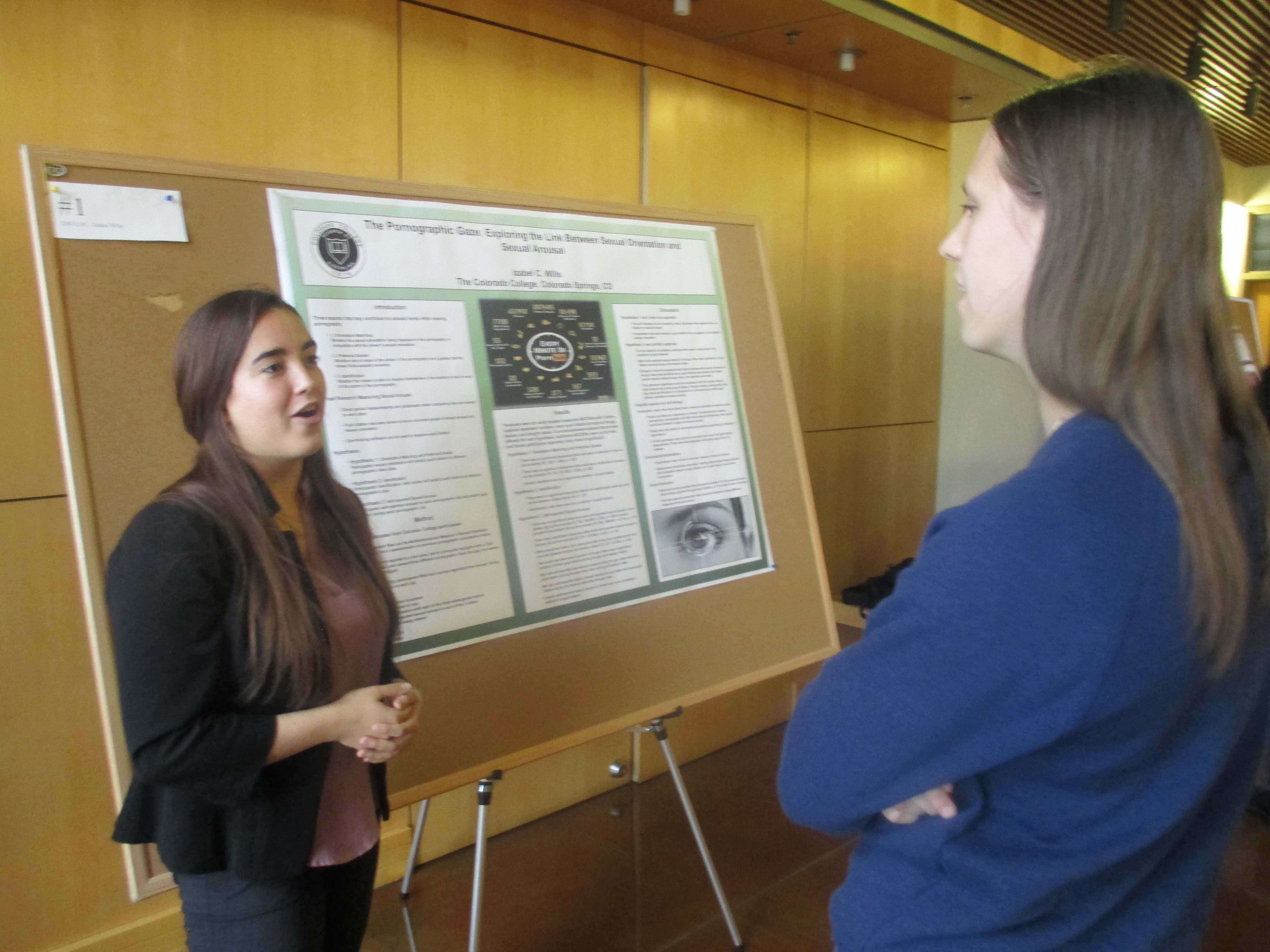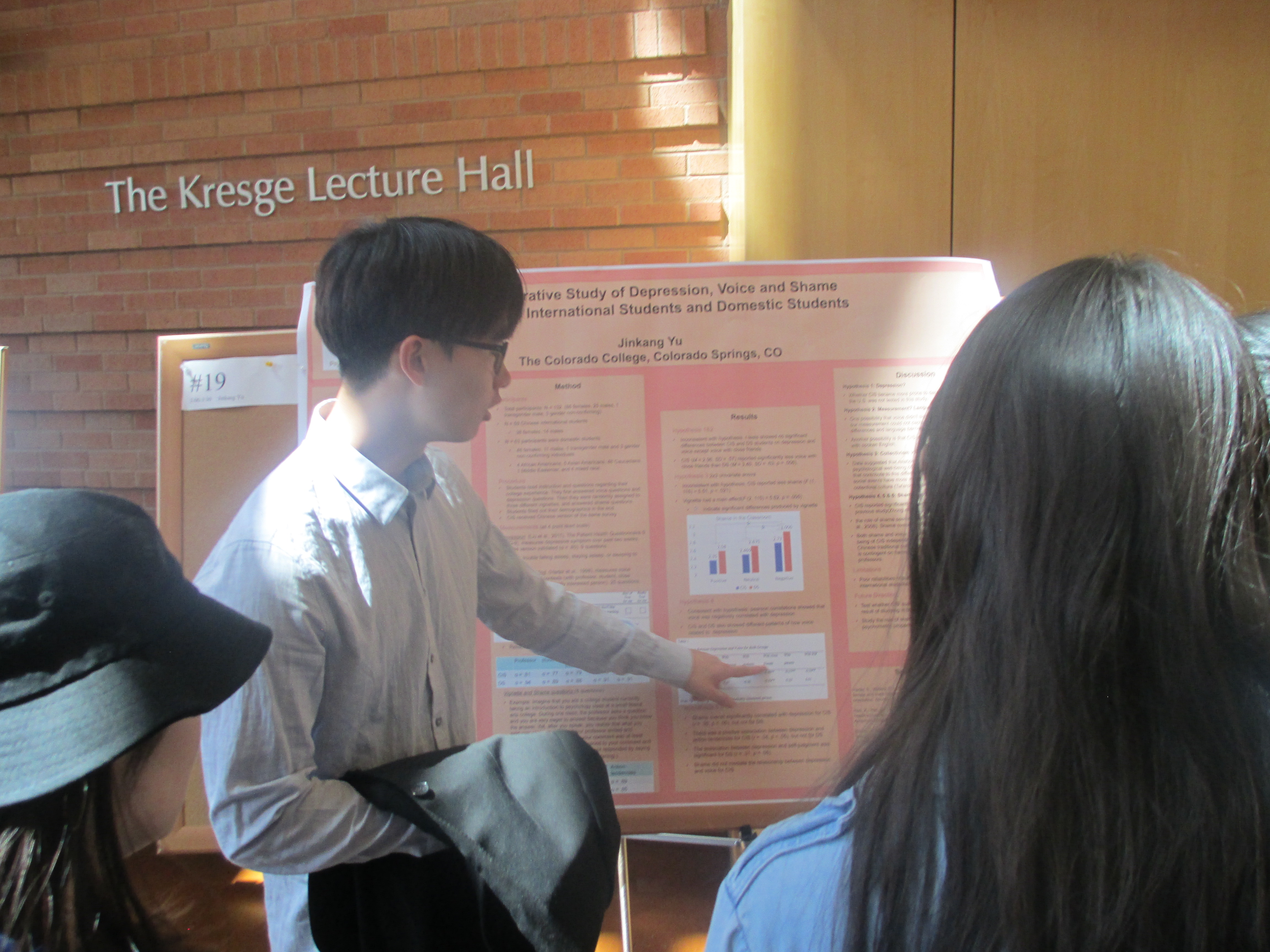Poster Day 2019
Psychology
Advisor: Tricia Waters
Rewriting "Madness": A Suggestion of Narrative Therapy in the Treatment of Borderline Personality Disorder
Borderline personality disorder (BPD) is notoriously difficult to treat. A history of trauma and familial conflict, an incoherence of identity, tendency towards self-harm, and a broad societal stigmatization that bleeds into self-stigma make matters of treatment harder. The construct itself produces considerable shame, especially in women labelled with the diagnosis. Though the construction of the disorder is societally influenced, BPD claims considerable lives and individuals report high levels of distress; thus, treatment is ethically necessary. This review outlines the philosophical frameworks of narrative therapy, especially its emphasis on personal experience, personal agency, externalization of the problem, and unique outcomes as uniquely positioned to aid in healing clients diagnosed with a culture-bound disorder. It is considered preliminarily as a possibility in the treatment of BPD to establish new and personalized narratives of healing from trauma and identity disturbance. The considerable lack of empirical research on narrative therapy leads to a discussion of areas for future research.
Psychology
Advisor: John Horner
State-Sponsored Supports for People with Intellectual and Developmental Disabilities in Transition to Adulthood: Three Case Studies in Colorado Springs
This study examines government-sponsored policies and supports for people with disabilities in Colorado who are transitioning into adulthood. Specifically, it focuses on an organization in Colorado Springs called Special Kids Special Families (SKSF) which has respite care for children and day programs for adults. The researcher spent 50 hours observing at two of SKSF’s programs: Zach’s Place and Joey’s Place. In addition to field observation, three mothers were interviewed about their experiences with Colorado’s policies and supports for people with disabilities and on their experience with assisting their child into adulthood. Based on these interviews, the researcher concludes that Colorado state government underfunds services for people with disabilities. Specifically, funding is needed for making the Developmental Disabilities (DD) waiver more accessible, decreasing the caseload of workers at The Resource Exchange (TRE) by hiring more employees, educating public school teachers on how to work with kids that have a variety of needs, and making Social Security Income (SSI) a livable wage. Other beneficial changes in policy would include simplifying the guardianship process and creating parent support groups. To help people with disabilities live fuller lives, these specific programs should be better funded and instated in Colorado.
Psychology
Advisor: Tomi-Ann Roberts
Created Without Them in Mind: Discrimination Against the Disabled in Healthcare
Perceived discrimination is an issue in healthcare that affects healthcare seeking behavior in the disabled population. Discrimination exists across various health services, such as primary care, preventative services and screenings, organ transplants, and reproductive services. Researchers have identified structural, behavioral and attitudinal barriers that are responsible for the inequalities in access to healthcare and therefore these barriers are interpreted as forms of discrimination. Structural barriers included inaccessible equipment, facilities that do not comply with ADA standards, and lack of transportation. Attitudinal barriers refer to the physician’s lack of knowledge and training on disabilities, negative perceptions and stereotypes about disabilities, and poor communication. Individuals who have both membership to a demographic minority and have a disability are more at risk for experiencing disparities in healthcare. Interventions have been proposed to eliminate barriers in healthcare. These include increasing accessible equipment and adding disability studies to medical students’ curriculum. Important limitations of the current research are the lack of generalizability to non-white, uninsured populations and lack of specific research on disability subgroups.
Psychology
Advisor: Jason Weaver
Exploring the Relationship Between Gender Identity and Sexual Orientation Identity
I explored whether there is a relationship between complexity of sexual orientation identity and complexity of gender identity. I used continuous and multidimensional measures of both gender identity and sexual orientation identity in order to increase the sensitivity of the measures to more complex identifications. Findings suggest that there is a correlation between level of complexity on one identity with complexity on the other. The relationship was not explained by any of the other variables explored (need for cognition, need for closure, sensation seeking, and openness).
Psychology
Advisor: Kevin Holmes
Crosslinguistic Comparison Promotes Flexible Conceptions of Categories
Research on categorization suggests that people regard membership in many categories as absolute (i.e., all-or-none) rather than a matter of degree (i.e., graded). However, languages differ dramatically in the category distinctions they encode, implying that category membership is not necessarily absolute. Here I show that learning about such linguistic diversity via analogical comparison facilitates graded conceptions of categories. Participants who compared contrasting categories from different languages were more likely to endorse graded membership for items in natural categories (e.g., fruit) and artifactual categories (e.g., furniture) than participants who received the same information without comparing. In fact, the latter group performed no differently than a no-exposure control group. These results suggest that comparing the category systems of different languages can reduce the propensity to categorize the world in absolutes. These findings have implications for language education and methods to reduce prejudice.
Psychology
Advisor: Kristi Erdal
False Beliefs about Symptoms, Cause, and Treatment of Depression
Depression is among the most common mental disorders and is identified by the World Health Organization as one of the worldwide leading causes of disability (Dietrich, Mergl, & Rummel-Kluge, 2014). In addition to the difficulty of dealing with sadness, depressive patients must overcome multiple emotional and cognitive barriers to engage in professional treatment, such as stigma and the lack of knowledge of treatment options. Past research has shown that the amount of knowledge on mental disorders impacts people’s attitudes toward them. The purpose of this research to systematically assess common beliefs and knowledge of depression from three perspectives: symptoms, causes, and treatments. In addition, the study explored if depression was more likely be attributed to external causes (e.g., poor nutrition) or internal causes (e.g., genetics), and would the attributions influence the perception of effective treatments. We recruited 236 participants using the Amazon Mechanical Turk population. The participants’ responses were coded for accuracy, the choice of causes (external vs. internal), and the treatment type (psychotherapy vs. biomedical). Overall, participants showed well-educated level of knowledge in regard to depression symptoms, but significantly more misconceptions towards the causes and treatment. Participants with higher level of knowledge psychotherapy over biomedical therapy (e.g., antidepressants) as the first-line treatment, while the people with low accuracy perceived biomedical therapy as the primary treatment for depression. Understanding the common beliefs toward depression and identifying the related predictor would not only contribute to the development of subsequent education but also help to improve the public’s misconceptions.
Psychology
Advisor: Jason Weaver
Is the Ritt Kellogg Climbing Gym a Gendered Space?
A gendered space is a geographical or architectural arrangement that delineates status differences between genders, creating inequality between them. One method to combat this inequality is to create single-gender groups and spaces, which removes these differences and may benefit individuals. Colorado College's Ritt Kellogg Climbing Gym employs this method through a a 2-hour shift every week for female-identifiers only, "Women's Wednesday." Anecdotally speaking, many female students attend this shift because they feel they must prove their strength to men and are intimidated by men's presence during normal hours -- despite the fact that male and female climbers worldwide are nearly equally balanced in rock climbing strength and skill. I conducted a survey in the gym to determine why female climbers still feel frustrated and vulnerable at the gym, and whether it is a male gendered space. Further, I examined whether Women's Wednesday is an effective way to combat the negative effects of men's presence on women's comfort levels.
Neuroscience
Advisor: Bob Jacobs
Comparative Neocortical Neuromorphology in the African lion (Panthera leo), African leopard (Panthera pardus pardus), and cheetah (Acinonyx jubatus)
The present quantitative study extends recent investigations in non-domestic felids by examining neuronal morphology in the neocortices of the African lion (Panthera leo), African leopard (Panthera pardus pardus), and cheetah (Acinonyx jubatus). Tissue samples were removed from prefrontal, motor, and visual cortices, and stained with a modified rapid Golgi technique. A total of 652 neurons were quantified using computer-assisted morphometry. Neurons in all species except the lion were sufficiently impregnated for accurate quantitative dendritic measurements. Despite poor stain quality in the lion tissue, descriptions of neuronal morphology were still possible. Qualitatively, the range of spiny and aspiny neurons across the three species was morphologically consistent with that observed in other felids (e.g., Siberian tiger, clouded leopard; Johnson et al., 2016), with typical pyramidal neurons being the most prominent neuronal type. Quantitatively, somatodendritic measures of typical pyramidal neurons in the cheetah were generally larger and more complex than those in the African leopard despite similar brain sizes. A MARsplines analysis of dendritic measures correctly differentiated 87.4% of complete typical pyramidal neurons between the African leopard and cheetah. Consistent with Jacobs et al. (2018), motor gigantopyramidal neurons were disproportionately large across all three felids, possibly due to specializations in their musculoskeletal systems and hunting behavior. The large size of these neurons in the cheetah, which unlike lions and leopards, does not belong to the Panthera genus, suggests that motor gigantopyramidal neurons evolved independently in these divergent felid species.
Psychology
Advisor: Tricia Waters
Mindset and Depression in Middle School Students
The relationship between implicit theories of intelligence and depression were examined in a sample of middle school students. A six week program was implemented. Groups differed based on undergoing an intervention designed to shift them from an entity to an incremental theory of intelligence. It was predicted than an intervention would decrease entity mindset and as a result, depression scores as well. Significant results were not observed using multiple Analyses of Variance (ANOVAs). There were trends towards significance supporting both hypotheses. Entity mindset and depression decreased for both the control and experimental group, indicating a potential activity effect of the more general program.
Neuroscience
Advisor: Lori Driscoll
Schema-Facilitated Information Processing: Bridging Memory and Perception
Our world is filled with an endless variety of sensory and conceptual information, and yet we make sense of it. We do so by comparing incoming information to stored reference templates, or “schemas”. Schemas are associative, semantic memory structures composed of commonalities between memories. While current schema literature focuses on the role of schemas in facilitating mnemonic processes (organizing encoding, consolidation, and retrieval), a separate field of study considers the role of schema-like categorization processes in perception. This review seeks to bridge perceptual (focusing on vision) and mnemonic literatures to present schema-facilitated categorization as a common organizing principle in neuronal information processing. Theoretical bases, neurobiological structures, and mechanisms of action of the schema are compared between mnemonic and perceptual literatures. Both describe category-specific representations stored within medial prefrontal cortex (mPFC) ensembles. The mPFC region is closely interconnected with hippocampal and inferior temporal lobe (ITC, located at the terminus of the ventral visual processing stream) regions. mPFC-hippocampal or mPFC-ITC connectivity is active during mnemonic or visual processes and serves to associate novel information with stored, category-congruent memories (mnemonic) or object representations (visual), facilitating categorization and interpretation. A unified model of schema-facilitated categorization from initial perception through systems consolidation is presented.
Neuroscience
Advisor: Lori Driscoll
Bifidobacterium infantis 35624 Buffers Medial Amygdala Activity In Male Rats
Gut bacteria are capable of influencing the developing nervous system, impacting behavior into adulthood. Bifidobacterium infantis 35624 (B. infantis) is a probiotic (beneficial bacterium) that has generated recent attention for its antidepressant and anxiolytic effects in rodents. The aims of the current study were to observe the effects of oral supplementation of B. infantis and exposure to chronic social defeat stress on stress resilience in healthy adolescent rats; and to determine if effects of B. infantis on stress resilience are dependent upon communication through the vagus nerve. Post weaning, male and female rats (N=85) either underwent a procedure in which the vagus nerve was severed below the diaphragm, or underwent a sham surgery; they were then supplemented with B. infantis or vehicle daily for 24 days. Stress resilience was defined by intact social exploration following a period of social defeat. After behavioral testing, activity of neurons in the medial nucleus of the amygdala was quantified using unbiased stereology of c-Fos immunopositive cell bodies. B. infantis supplementation was found to increase stress resilience as well as lower c-Fos expression in the medial amygdala of male but not female rats. In addition, the effects of B. infantis on male rats was dependent upon an intact vagus nerve. These results indicate that B. infantis can influence stress resilience by communicating with the amygdala via the vagus nerve and its targets.
Neuroscience
Advisor: Lori Driscoll
Oral Supplementation of the Probiotic Bifidobacterium infantis Increases Resilience to Social Stress in Adolescent Male Rats
Accumulating evidence shows that the gut microbiota contributes to the pathogenesis of stress-related disorders. For example, the probiotic Bifidobacterium infantis (B.infantis) reduces anxiety in adults with irritable bowel syndrome. B.infantis is enriched in the human infant gut, and it could potentially play a mitigating role in the development of the stress response and stress resilience. However, this relationship remains to be fully characterized. In addition, a clearer understanding of the mechanisms by which B.infantis exerts its effects on the CNS is needed. The objective of the present study was to examine the effects of oral supplementation of B.infantis 35624 on resilience to social stress in healthy, adolescent rats, and to elucidate the contribution of the vagus nerve (CN-X) to such effects. Adolescent male and female adolescent rats (N = 85) received either a subdiaphragmatic vagotomy or sham surgery before being orally administered the B.infantis probiotic or vehicle once a day for 24 consecutive days. All rats were introduced to a modified resident-intruder paradigm for three days to model social defeat. Social behaviors were measured in a social interaction test both prior to and following the completion of the resident-intruder paradigm. Our results demonstrate a sex difference in how the B.infantis probiotic influences social anxiety-like behavior: the probiotic increases stress resilience in males but not females, likely by signaling through the vagus nerve.
Psychology
Advisor: Kristi Erdal
Relationships between Culture, Westernization, and Mental Health in Northern Chile: An Examination of Intercultural Mental Health
Globalization has spread Western perceptions of mental health and mental illness to the rest of the world, complicating the deep relationship between culture and mental health. The goal of this study was to explore the relationship between culture and mental health in Northern Chile, and how Westernization has impacted this relationship among the Aymaras, the predominant indigenous population in the region. This required understanding the relationship between traditional medicine and Western medical practices and how effectively the two have come together in Chile’s recent efforts to create an intercultural model of mental health. This qualitative study was conducted over in the Arica and Parinacota region. Using semi-structured interviews with 18 participants. Findings clarified the strong distinctions between Aymaran perceptions of psychological well-being and Western concepts of mental health, confirming the strong relationship between culture and mental health. Results were also indicative of several successes of Chile’s intercultural health care system, providing a space of validation for traditional medicine, and in most cases giving patients the autonomy to choose the model of care that is most effective for themselves. However, participants’ responses also highlighted a deeply engrained power dynamic between Western and traditional medicine that is currently preventing the intercultural health care system from functioning at its most effective potential.
Neuroscience
Advisor: Kristi Erdal
Self-Stigma of Mental Illness: Predictors, Consequences, and Outcomes
Individuals who experience self-stigma, the internalization of public stigma of mental illness, frequently confront marginalization and disadvantaged life outcomes. Grounded in the Modified Labeling Theory, current methodologies of studying self-stigma of mental illness focus primarily on the relationship between self-stigma and general life outcomes (e.g., quality of life). Predictors of self-stigma (i.e., social networks, mental illness diagnosis, employment, education, and familial stigma) rely on societal structures and deviance from social norms. Given that high self-stigma is correlated with low quality of life, researchers are attempting to develop interventions which mitigate self-stigma. Although research has expanded globally, gaps in self-stigma interventions persist despite a growing understanding of the internalization process and associated negative outcomes. Given the influence of public stigma on self-stigma, intervention methods should focus on diminishing public stigma.
Neuroscience
Advisor: Lori Driscoll
Bifidobacterium infantis Supplementation in Adolescent Eubiotic Rats Influences Social Preference, but not Sucrose Preference Following Social Defeat
There is growing evidence that mammalian gut microbiota contribute to central nervous system development and functioning. Gut microbiota modulate behavior through multiple communication pathways with the brain (i.e., immune, hormonal, and neural signaling); however, the relative significance of each of these pathways to gut-brain communication, and to neural development, remains to be elucidated. The purpose of the current study was twofold: to determine the impact of supplementation, in adolescent rats, with the probiotic Bifidobacterium infantis 35624 on the development of social motivation and resilience to social defeat; and to understand the extent to which this influence can be attributed to neural signaling via the vagus nerve. Adolescent rats were subjected to either total subdiaphragmatic vagotomy or sham surgery, and were orally supplemented with either B. infantis or vehicle for 24 consecutive days. Following this, rats were assessed for hedonic motivation with a social preference test, and after a 3-day period of continuous social defeat, a sucrose preference test. B. infantis treatment significantly increased social exploration in the social preference test for females, but not males. B. infantis treatment had no effect on sucrose preference, whereas vagotomy was associated with reduced sucrose preference. These findings suggest that although B. infantis supplementation may improve spontaneous social preference in healthy female rats, it does little to normalize sucrose preference in socially defeated rats. Additional research is warranted to better understand the role of probiotics in the development of hedonic motivation, and to determine the unique contribution of the vagus nerve to gut-brain communication.
Neuroscience
Advisor: Lori Driscoll
Bifidobacterium infantis 35624 Supplementation in Eubiotic Adolescent Rats Promotes Social Preference and Reduces Anxious Behaviors
Gut microbes inhabit the mammalian gut and communicate with the brain through immune, endocrine and neural signaling. There is increasing evidence that the gut microbiome substantially contributes to normal central nervous system (CNS) development and function; however, the exact mechanism by which these microbes exert their effects, are yet to be determined. The aim of the present study was to assess the impact of Bifidobacterium infantis 35624 (B. infantis) supplementation during adolescence on preference to socially interact and anxious behavior in rats, and if any, to what extent this influence is mediated by neural signaling via the vagus nerve. Adolescent rats (N = 85) received either a complete subdiaphragmatic vagotomy or sham surgery and were subsequently orally supplemented with B. infantis or a vehicle for 24 consecutive days. Following supplementation, the rats were subjected to a battery of behavioral tests which assessed spontaneous desire for social contact and anxious reaction to forced social contact. B. infantis supplementation significantly increased social exploration of the stranger rat in female rats, but not males. Vagotomized males displayed increased social exploration of the stranger rat after B. infantis supplementation, whereas vagotomized females displayed decreased social exploration after B. infantis supplementation. The present results suggest that although B. infantis supplementation may promote motivation to engage in social contact, supplementation decreases high-stress social interaction in female rats. These findings also illustrate that the vagus nerve may be involved in communicating anxious behavior in male rats.
Psychology
Advisor: Kevin Holmes
Spatial Categories in Language and Thought: Evidence for Categorical Perception at the Cardinal Axes
There are two contrasting positions concerning the relationship between linguistic and nonlinguistic spatial categories. One position suggests, naturally enough, a close correspondence between the two sets of categories, with prototypes on the vertical and horizontal axes. The other position suggests a dissociation, in which the cardinal axes function as the boundaries of nonlinguistic categories and the protoypes of linguistic categories. The latter account predicts categorical perception (CP) at the axes—i.e., superior discrimination of locations straddling an axis compared to non-axial locations. Here we provide the first direct test of this prediction, showing that cross-axis locations are discriminated faster than non-axial locations in spatial scenes separated by a delay. We also show that such CP is stronger along the horizontal dimension than the vertical, consistent with the dimensional disparity between left-right and above-below found in language. Our findings reveal a significant point of congruence between linguistic and nonlinguistic spatial categories, suggesting refinements to the dissociation account of the relationship between them.
Psychology
Advisor: Jason Weaver
The Pornographic Gaze: Exploring the Link Between Sexual Orientation and Sexual Arousal
The way in which people react to and view pornography is an under researched area. The present study sought to explore the link between sexual orientation and sexual arousal to various erotic stimuli. Participants viewed three 40 second pornographic clips (heterosexual, homosexual, and lesbian) while an eye-tracker recorded their pupil diameter throughout each video. Pupil dilation was used to measure changing levels of sexual arousal to each video. Participants were also asked whether they felt aroused during each video to ensure that pupil dilation was an accurate measure of sexual arousal. There were mixed, inconclusive findings for self-reported sexual arousal as a predictor of pupil dilation. Furthermore, sexual orientation was not a significant predictor of pupil dilation changes between different sexual stimuli. Ultimately, pupil dilation as measured by an eye-tracker may not be an accurate gauge of sexual arousal.
Psychology
Advisor: John Horner
We Thought We Were Rational: Contexts Effects in Choice-making
Context effects, which arise when a newly added third option alters an individual’s preferences between two options, have drawn a great deal of attention from researchers for their wide-ranging practical and theoretical implications. The demonstration of these effects violates a few widely accepted interpretations of choice behaviors including simple scalability and Luce’s (1959) ratio-of-strengths theory (Krantz, 1964). In the present study, we examined three major context effects—attraction, compromise and similarity effects—in a new experimental setting that contained probability judgement and expected payoff calculation. The findings suggest that different cognitive process might be employed, causing manifestations of context effects which deviate from previous studies’ findings within the probability-value paradigm.
Psychology
Advisor: Tricia Waters
A Comparative Study of Depression, Voice, and Shame in Chinese International Students and Domestic Students
Scholars have argued that there is an emerging mental health crisis among Chinese international students in the U.S. The present study delved into the experience of depression, voice, and shame of Chinese international students and domestic students, and found that both groups were equal in terms of severity of depression. “Voice” reflects the degree to which people express their thoughts in different social relationships, and in previous research, voice has been negatively correlated with depression. Chinese international students’ voice with close friends was lower than domestic students, in the current study. Further, in Chinese international students, voice across all social contexts was negatively correlated with depression, while in domestic students, only voice with close friends was negatively correlated with depression. In addition, shame was positively correlated with depression, but only in Chinese international students.
show all / hide all



